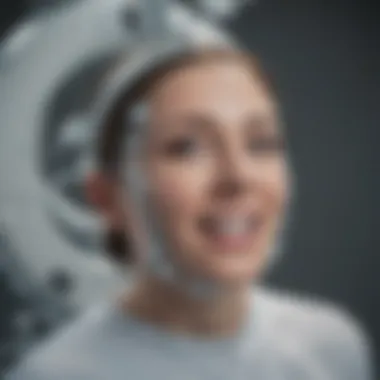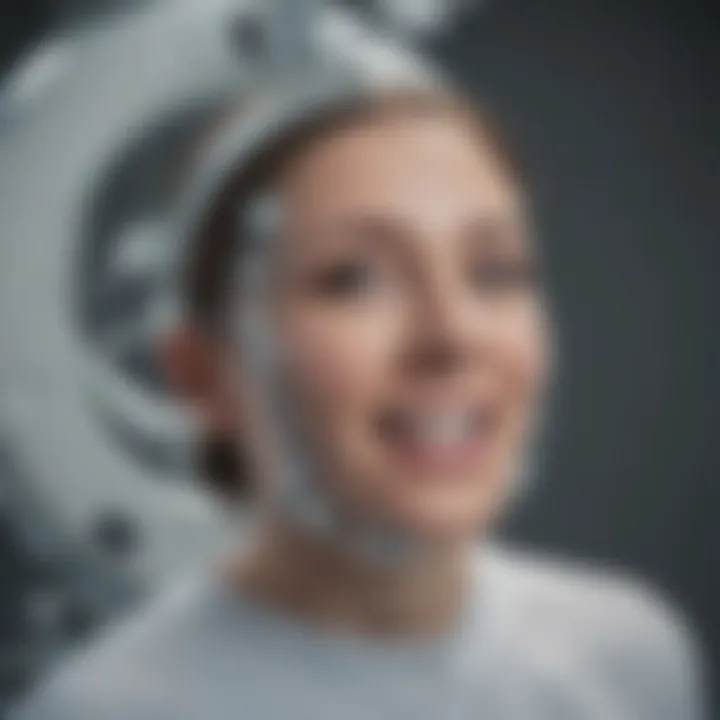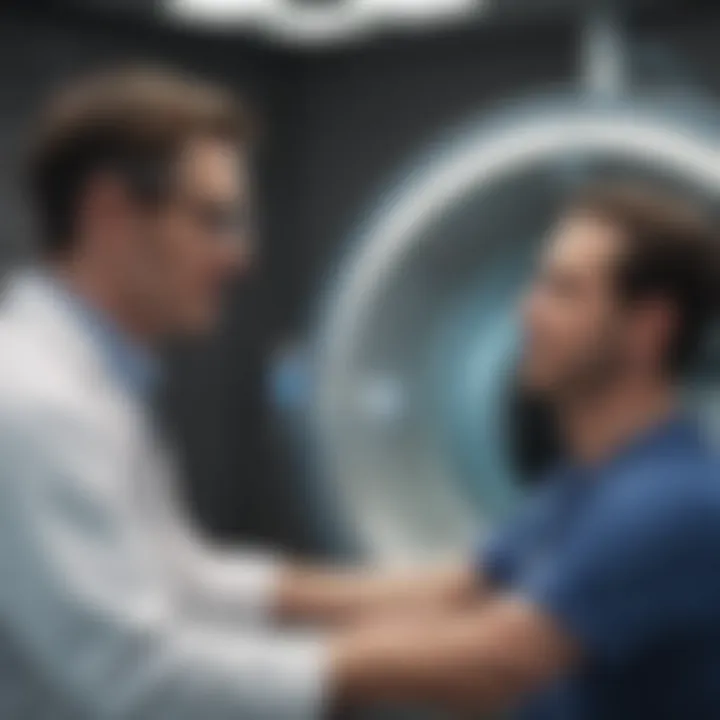MRI Scans for Patients with Braces: What You Need to Know


Intro
MRI scans are critical imaging tools for diagnosing many health conditions. However, patients with braces present a unique set of challenges. Understanding these challenges can aid in better preparation for the procedure and ensure that the scans yield accurate results. This article dives into the intersection of orthodontic care and MRI imaging, shedding light on what patients need to know when navigating this process.
Research Highlights
Overview of Key Findings
Research indicates that metal components in braces can interfere with MRI scans, potentially degrading image quality. The extent of this interference largely depends on the type of metal used in the braces. Some materials produce artifacts that can obscure essential diagnostic information.
Significance of the Research
The significance of this research lies in improving patient outcomes. Better understanding the interaction between dental appliances and imaging modalities can lead to refined protocols at MRI facilities. This can minimize the risk of repeated scans, thus reducing patient discomfort and healthcare costs.
"Patients should inform their MRI technicians about any dental appliances to ensure optimal imaging strategies are employed."
Considerations for Patients with Braces
When preparing for an MRI, patients with braces should consider several critical factors:
- Informing Technicians: Always disclose the presence of braces and any other dental appliances to medical staff.
- Potential Adjustments: Discuss with your orthodontist about any necessary adjustments to your braces before the MRI.
- Image Quality Concerns: Understand that the quality of images may be hindered due to the metallic components in braces. The radiologist may need to adapt the imaging technique to account for this.
Practical Steps for Patients
For those preparing for an MRI scan, the following steps can be beneficial:
- Consult Your Orthodontist: Before the MRI, have a conversation with your orthodontist. They may provide guidance on the best course of action.
- Schedule Accordingly: Find a facility experienced with orthodontic patients. They might have specific protocols to accommodate your needs.
- Ask Questions: Clear any doubts with the MRI facility regarding how they handle patients with braces.
Epilogue
Understanding MRI Technology
MRI technology plays a crucial role in modern medicine, particularly in diagnostic imaging. For patients with braces, understanding how MRI works is essential. This knowledge helps clarify any concerns regarding the procedure and how dental appliances might affect the scanning process.
MRI, or Magnetic Resonance Imaging, is a non-invasive imaging technique that uses strong magnetic fields and radio waves to generate detailed images of organs and tissues within the body. Unlike X-rays or CT scans, MRIs do not use ionizing radiation, making them a safer alternative for certain medical evaluations. This characteristic is especially important for patients with braces, as it minimizes exposure to harmful radiation and allows for a clearer view of soft tissue structures.
Furthermore, the ability to visualize specific areas without surgery is a significant advancement in medical technology. MRI scans can help diagnose a wide range of conditions, from neurological disorders to joint problems, ensuring that patients receive appropriate care without unnecessary invasive procedures.
What is an MRI?
Magnetic Resonance Imaging (MRI) is a medical imaging technique that utilizes strong magnetic fields and radio waves. The process generates high-resolution images of organs and other internal structures within the body.
- Non-invasive: It allows visualization of the inside of the body without needing surgical intervention.
- Safe: MRI scans do not expose patients to ionizing radiation, unlike other imaging methods such as X-rays and CT scans.
- Detailed Images: MRI produces superior soft tissue contrast, making it effective for diagnosing conditions in the brain, muscles, and ligaments.
Understanding MRI can ease the anxiety experienced by patients undergoing the procedure, specifically those with braces, as they realize that the technology is designed to ensure safety and provide essential diagnostic information.
The Mechanics of MRI Scanning
The mechanics of MRI scanning involve several intricate steps, each designed to ensure accuracy and safety. First, the patient lies down on a moveable table, which then slides into the MRI machine. The machine uses magnets to create a magnetic field, aligning the nuclei of hydrogen atoms within the body.
When radio waves are sent through the body, these hydrogen atoms are temporarily knocked out of alignment. Once the radio waves are turned off, the atoms return to their original positions, releasing energy in the process. This energy emission is detected by the MRI machine and is converted into images that radiologists analyze for diagnostic purposes.
Important parameters that play a role in the MRI process include:


- Magnetic Field Strength: Measured in tesla (T), higher field strengths yield better image quality.
- Radiofrequency Coils: These coils send and receive radio waves, improving the clarity of the images.
- Sequence Parameters: Different MRI sequences can be used to highlight specific types of tissue or pathology, enhancing the diagnostic process.
For patients with braces, it is vital to consider the materials used in the braces and their interaction with MRI's magnetic field. Understanding the mechanics can help alleviate concerns about potential interference or complications during the scan.
The Role of Braces in Dental Health
Understanding the role of braces is essential when discussing MRI procedures for patients wearing them. Braces are common orthodontic devices used to correct misalignment of teeth and jaws. This alignment is crucial not only for aesthetics but also for overall dental health. Misaligned teeth can cause problems with chewing, increase the risk of tooth decay, and may lead to issues with jaw pain or headache. Thus, when patients with braces require an MRI scan, special considerations arise that influence both their dental treatment and imaging outcomes.
Overview of Orthodontic Treatment
Orthodontic treatment focuses on diagnosing and correcting irregularities in teeth and jaws. The most prevalent forms of orthodontic devices include metal braces, ceramic braces, and more recently, clear aligners like Invisalign. Each of these systems has unique attributes, but their core function remains the same: to ensure proper alignment over time.
The typical orthodontic process involves a thorough evaluation, which may include X-rays and digital scans. This initial assessment helps in designing a customized treatment plan. Patients often wear braces for a period ranging from several months to a few years, depending on the complexity of their case. Regular follow-ups ensure that the treatment progresses as planned.
Materials Used in Dental Braces
The materials used in dental braces can greatly impact patient comfort and treatment effectiveness. Metal braces, the most traditional type, use stainless steel brackets and archwires. These metal components are durable and effective for correcting serious misalignments. In contrast, ceramic braces, made from tooth-colored materials, offer a more aesthetic solution but may be less durable.
Additionally, rubber bands or ligatures of various colors are often utilized to enhance the effectiveness of braces.
- Stainless Steel: Durable and effective for most cases.
- Ceramic Materials: Aesthetic option, less visible than metal.
- Clear Aligners: Offer removable options for alignment without traditional brackets.
While these materials serve specific purposes in orthodontic treatment, their metallic properties can present challenges during MRI scans. Understanding the implications of these materials is critical for ensuring patient safety and achieving optimal imaging results.
Compatibility of Braces with MRI Procedures
Understanding the compatibility of braces with MRI procedures is crucial for both patients and healthcare providers. As this article outlines, patients with orthodontic appliances face unique challenges when undergoing MRI scans. This section delves into specific aspects of compatibility, including the interactions between magnetic fields and metallic components, and essential safety protocols designed to protect patients during the scanning process.
Magnetic Fields and Metallic Objects
The nature of MRI technology relies heavily on strong magnetic fields, which can interact with metallic objects in various ways. Braces typically contain metallic components, such as brackets and wires, which may influence the quality of imaging.
When a patient with braces undergoes an MRI, the metallic parts can cause image distortions, potentially leading to misdiagnosis or inadequate evaluation of underlying tissues. The interaction can also create artifacts, which are false signals that appear in the images. Therefore, it is essential for healthcare providers to assess the materials used in dental braces before scheduling an MRI.
Patients should communicate openly about their orthodontic devices. Many braces are constructed from materials, like stainless steel, titanium, or other alloys, which may react differently to magnetic fields. Knowledge of these materials helps technicians decide on the best imaging strategies, or if alternative imaging methods should be considered.
"Understanding the impact of metallic objects, like braces, on MRI scans is vital for ensuring accurate diagnostics."
Safety Protocols for Patients with Braces
Safety protocols play a key role in ensuring the well-being of patients with braces during an MRI. Before the scan begins, it is critical to inform the MRI technician or radiologist about any dental appliances. These professionals are trained to evaluate the specific scenario and implement necessary adjustments.
Common safety protocols include the following:
- Pre-screening Questionnaire: Patients should fill out forms regarding any metallic implants or devices.
- Device Assessment: The technician may check the type of braces to determine compatibility with MRI.
- Adjusting Procedures: If needed, the technician can adapt the scanning parameters to reduce the risk of artifacts.
In some cases, the MRI may be performed with particular protocols aimed at minimizing the interference caused by braces. Overall, collaboration between the patient and healthcare professionals is critical in navigating MRI procedures successfully.
Knowledge of safety protocols fosters a better understanding for patients. By being aware of the potential challenges and safety measures, individuals can mitigate the risks associated with MRI scans while wearing braces.
Thus, with the right precautions and awareness, MRI scans can be performed safely and effectively, ensuring quality imaging and patient care.
Potential Challenges During MRI Scans
When it comes to MRI scans for patients with braces, recognizing the challenges is paramount. These challenges affect not only the quality of the imaging results but also the overall experience for the patient. Braces, while essential for dental treatment, can introduce specific obstacles. Addressing these challenges minimizes negative outcomes and enhances patient understanding of the procedure.


Image Distortion and Artifacts
One of the primary concerns for patients with braces during MRI scans is the potential for image distortion. The metallic components in braces can interfere with the MRI's magnetic fields, leading to artifacts in the images. Artifacts can make it difficult for radiologists to accurately interpret results. For example, high signal intensity regions caused by the metal can obscure critical areas of interest in the images, complicating diagnosis.
It's essential to note that most modern MRI machines have advanced technologies that help reduce these distortions. However, patients should be aware that some level of interference may still occur, and they should discuss this with their healthcare provider. Understanding these challenges can prepare patients effectively; knowing that precautionary measures are in place can ease anxiety about image quality.
Patient Comfort and Procedure Duration
Comfort is another significant factor during MRI scans for patients with braces. The procedure often requires patients to lie still for an extended period, which can be uncomfortable, particularly for children or individuals new to the experience. Patients wearing braces might have additional concerns about their dental appliances during the process.
Moreover, the duration of the scan can vary based on the protocol and the specific images needed. Some scans may take longer if the technician needs to repeat images due to interference from the braces. Patients may feel anxious during this time, especially if they are unsure about the effects of their braces on the process.
To help improve comfort levels, facilities should inform patients about the expected duration and the importance of remaining still. Additionally, desensitizing patients to the machine's noises and environment beforehand can significantly reduce anxiety. Taking into consideration both the physical and psychological comfort of patients can lead to a more successful MRI experience.
In summary, being aware of potential challenges such as image distortion, artifacts, and patient comfort can help alleviate concerns for those undergoing MRI with braces.
By focusing on these challenges, healthcare providers can better prepare patients and tailor the MRI procedure to their individual needs.
Professional Recommendations
Professional recommendations are crucial when navigating the complexities of MRI procedures for patients with braces. These suggestions serve to optimize patient safety, enhance the quality of imaging results, and ensure compliance with medical protocols. Understanding these recommendations can be beneficial for both patients and healthcare providers in managing orthodontic treatment during imaging procedures.
First, consulting with healthcare providers is essential. Dentists, orthodontists, and radiologists should collaboratively evaluate the implications of braces during an MRI appointment. They can address concerns regarding potential interference from orthodontic hardware with magnetic imaging, advising on what to expect during the procedure and any necessary precautions that should be taken.
Another key element of professional recommendations involves preparing adequately for the MRI appointment. This includes informing the MRI facility about the presence of braces, which will allow technicians to carry out additional safety checks and adjust protocols as needed. Proper preparation can significantly mitigate issues related to discomfort and ensure a smoother experience during the scan.
Some benefits of following professional recommendations include:
- Improved image clarity by addressing the effects of braces on MRI results.
- Enhanced patient comfort through clear communication of the process and expectations.
- Lowered risk of complications arising from unanticipated interactions between braces and MRI machinery.
In summary, professional recommendations form the backbone of effective MRI procedures for patients with braces. They emphasize the importance of a comprehensive approach, ensuring that all healthcare providers are on the same page and that patients are adequately informed about what lies ahead.
Consulting with Healthcare Providers
Consulting with healthcare providers is essential for patients with braces who need an MRI. This process begins with a thorough discussion between the patient and their orthodontist or dentist, who can provide insights regarding the materials used in the braces and the potential implications for MRI imaging.
Healthcare providers can offer the following key advice:
- Assess the type of dental braces used: Most braces are made from materials that are compatible with MRI, but some specific types may pose challenges. The provider will clarify these points.
- Evaluate the urgency of the MRI: If the MRI is urgent, the provider may suggest alternative imaging methods or provide specific guidance on how to proceed with the MRI despite having braces.
- Discuss any allergies or other health concerns that could affect the MRI process: This ensures a tailored experience that addresses all patient needs.
Involving healthcare professionals minimizes the chance of surprises during the MRI and provides patients with a clear understanding of the process ahead.
Preparing for Your MRI Appointment
Preparing for your MRI appointment is crucial, particularly for patients wearing braces. The preparation phase can make the difference between a stressful experience and a smooth procedure. Here are several steps to consider:
- Notify the MRI facility about your braces prior to the appointment. This allows the facility to prepare accordingly, ensuring all safety measures are in place.
- Follow any fasting or medication instructions given by your healthcare provider. Knowing whether to eat or take medications can impact the procedure.
- Wear comfortable clothing without metal parts. This minimizes the chances of access issues during the scan.
- Arrive early to fill out any necessary paperwork. This gives staff enough time to handle special requests related to your braces and review medical history.
- Prepare a list of questions. Write down any queries related to the MRI, particularly concerning how your braces may affect the scan and any potential adjustments that may be necessary during the procedure.
By taking these steps, patients can ensure that their MRI appointment is handled with the utmost care and attention, leading to better outcomes and improved experiences.
Alternatives to Traditional MRI Scanning
MRI scans are essential in providing detailed images of the body's internal structures. However, for patients with braces or other dental appliances, these scans can present unique challenges. As a result, seeking alternatives to traditional MRI scanning becomes important not just for comfort but also for obtaining clear and accurate images. The reasons to consider alternatives can vary—from minimizing discomfort to addressing concerns about image quality due to metallic implants.


A shift towards alternative imaging methods may provide beneficial solutions. Knowing these options can empower patients and healthcare providers to make informed decisions that best suit unique needs.
Utilizing Alternative Imaging Methods
There are several alternative imaging methods available that can substitute traditional MRI scans. Each of these comes with its own benefits and limitations. Some notable alternatives include:
- CT Scans: Computed Tomography (CT) scans use X-rays to create detailed cross-sectional images of the body. While they have a different imaging mechanism, they can often provide necessary details without interference from braces.
- Ultrasound: This method employs high-frequency sound waves to generate images. It is a radiation-free option, making it safer for many patients. However, its effectiveness depends on the area being examined.
- X-rays: Traditional X-rays, while less detailed than MRIs, can still provide valuable information, especially in dental assessments.
These alternatives may not always match the detail an MRI would provide, but they can effectively address certain diagnostic needs, particularly if the influence of metallic braces is considerable.
When to Consider Other Options
Deciding when to opt for alternative imaging requires careful consideration. Key factors include:
- Nature of the Diagnosis: If the health issue does not specifically require an MRI, a CT scan or ultrasound might be sufficient.
- Comfort and Tolerance: Patients with sensitivities or fears surrounding MRI scans may prefer alternatives, as they tend to be less confined and quicker.
- Consulting Professionals: Always consult with healthcare providers. They can offer insights based on individual health circumstances and current dental conditions.
"Selecting the proper imaging method depends on numerous factors, including patient comfort, diagnosis, and specific circumstances surrounding the braces."
Case Studies and Real-world Experiences
Understanding how patients with braces respond during MRI procedures can help both medical professionals and patients. Case studies provide real-world examples of challenges and solutions in these scenarios. They offer insights into patient outcomes and help shape future practices in imaging.
Patient Outcomes with Braces during MRI
Patients have diverse reactions when undergoing MRI scans while wearing braces. Many individuals report minimal discomfort during the procedure. However, some face challenges with image acquisition due to artifacts caused by metallic components of braces. In cases where braces are involved, the quality of images may be affected.
Several studies indicate that certain designs of braces can lead to distortions in MRI images, particularly those involving intricate metal structures. These distortions can obscure important anatomical details.
- Success Stories: There are several documented cases where patients with braces received clear MRI results. These instances typically involved:
- Patients using braces with specific materials that are less susceptible to magnetic interference.
- A thorough pre-scan assessment ensuring the MRI technicians are aware of the patient’s dental appliance.
In such cases, clinicians often reported they could effectively diagnose conditions, albeit with some adjustments to standard imaging techniques. It illustrates that, under right conditions, MRI can still provide useful diagnostic information.
Expert Opinions on Best Practices
Experts emphasize the need for clear communication between patients, orthodontists, and radiologists. Here are some best practices that arise from expert observations:
- Pre-Procedure Preparations: Consulting orthodontists before scheduling an MRI is critical. They can confirm whether the braces are compatible with the procedure.
- Image Quality Considerations: Professionals recommend the use of specific MRI techniques that mitigate artifacts caused by braces. This may include:
- Safety Protocols: Experts advocate for strict adherence to safety protocols during the MRI. Patients should disclose their orthodontic hardware to technicians before the scan begins.
- Selecting a certain MRI pulse sequence designed to enhance image clarity in the presence of metallic objects.
- Utilizing high-resolution images to reduce ambiguity.
In a systematic review, it was noted that educational and procedural modifications made in facilities can significantly improve safety and outcomes for patients with dental braces.
Overall, studying real-world experiences and expert opinions enriches our understanding of MRI procedures involving braces. It highlights the necessity for ongoing dialogue and adaptation in the practices surrounding these procedures.
Epilogue
In summary, this article highlights the intricate relationship between MRI procedures and patients wearing braces. Understanding the compatibility of metal braces with MRI technology is essential for both patients and healthcare providers. This section emphasizes key considerations that arise when preparing for an MRI scan.
Summarizing Key Points
- MRI Technology Understanding: MRI machines utilize strong magnetic fields and radio waves to create detailed images of the body. Knowing how these technologies work can help patients appreciate their importance in diagnosing conditions.
- Impact of Braces: Dental braces are made of metal, which may interact with the magnetic field of the MRI, potentially leading to image distortion. Hence, effective management is required to ensure that images remain clear for accurate diagnosis.
- Safety Protocols: Patients with braces should always inform their radiologic technologist about their dental appliances. This information is crucial for the safety protocols implemented during the MRI scan.
- Professional Consultation Importance: Consulting with healthcare providers about the presence of braces ahead of the MRI appointment is vital. They can provide tailored advice and solutions.
- Alternatives and Adjustments: Exploring alternatives to MRI, such as CT scans or X-rays, may sometimes be necessary. Patients must consider these options based on their specific needs and circumstances.
Future Considerations in MRI and Orthodontics
As technology advances, the intersection between orthodontics and imaging will likely evolve. A few future considerations include:
- Improved Imaging Techniques: Researchers are continuously working on technologies that minimize the influence of metal objects like braces on MRI outcomes. This could lead to more accurate imaging for patients with braces.
- Tailored MRI Protocols: Facilities may develop protocols specific for patients with braces, ensuring safety and enhancing image quality.
- Greater Patient Awareness: There should be efforts to increase awareness among patients about the implications of braces on MRI scans. This involves better informational resources from both orthodontists and radiologists.
The ongoing dialogue between orthodontic health and imaging technology is essential as it can lead to more informed decisions in the healthcare sphere.







